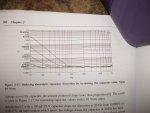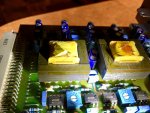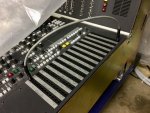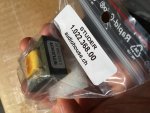[MENTION=201181]michael1991[/MENTION]
I would definetly recommend to try some bypass foil condensators over the electrolytics.
I’m actually not too interested in that, because modern electrolytics offer much better performance than in the past, and I’ll have to dig up the specifics, but there are potential issues having the two different caps in parallel. There’s a trade-off. In the past, with lower quality electrolytics, it was a worthwhile compromise, but that’s not so much the case now.
As little background info:
electrolytic caps are polar components, and the schematics look like there is no dc offset in the circuits intended.
Electrolytic caps are either polar or non-polar. The non-polar parts offer better sonic performance than their polar counterparts, but non-polar signal path caps only work in a circuit that is properly biased so signal flows properly. Plus they are more expensive. So we typically see polar parts used. Which is *fine*. There is nothing wrong with that and top-notch gear uses polar parts...and has DC offset throughout the signal path because of the opamps. This is normal. The the coupling caps get rid of it. Effective, and economical.
DC offset is a natural consequence of opamp circuits. That’s precisely why there are signal path coupling caps. So while DC offset is isn’t “intended”, it’s there because of the opamps and therefore it needs to be arrested. That’s one reason transformer coupled circuits are, in at least one way, desirable. Transformers don’t pass DC. So in a transformer coupled circuit the transformer negates the need for the coupling caps. But then there are the transformer artifacts...less of a concern with more expensive transformers, but then there’s a cost trade-off...there’s *always* a trade-off. Another approach is a carefully designed circuit with no DC offset. I’m getting some ongoing guidance collaborating on a project to redesign the line driver amps in a prototype Tascam console I have. They are powered by +/-35V power rails from the factory...really high headroom...like near tube amp headroom, but the factory design doesn’t perform well at lower impedances. The discrete output stage of the redesigned circuit is carefully biased to produce no DC offset down to silly-low impedances. No DC offset = no output coupling caps. But it is much more complicated and expensive than a typical line out driver, and requires the high power rails...also a complication; trade-offs. Always trade-offs.
This means that the neagtive parts of the signal go through he caps in the "false" direction. Since the signals are not large, this will not destroy the caps, but this will introduce nonlinear distortions. Because of that i choosed higher voltage ratings on the electrolytics. I do not know how the parallel foil caps behave in this combination in theory. All I can state so far is, that I really like what the do soundwise.
Well if you’re happy with it, don’t let anybody tell you different, but increasing the voltage rating won’t help the non-linear distortion of the cap. The higher voltage rating will only help the cap survive a catastrophic failure in the circuit where the cap experiences the maximum voltage hit...like where something zorches and the cap gets hit with the DC direct from the power rail, which is the max voltage the cap could possibly see. So that’s why you choose a voltage rating that is greater than the power rail. Studer did that. The power rails are +/-15V. They used 16V caps. The power rails are throttled a bit throughout each PCB assembly. So the power rails are actually somewhere in the 13.5V range. That means lower headroom, BUT a more reliable longer-lasting device. That’s one of the things the 928 is known for in the mobile and broadcast arena...reliable. Trade-offs. But Studer was also dedicated to “good sound”, and headroom is part of that. By using balanced drivers and creative amplifier circuits throughout, kept the headroom at the ins and outs of each module. Smart. So the 16V caps aren’t unreasonably low in their voltage rating. Might 25V be better? Probably wouldn’t hurt, but not really necessary because the 16V cap is rated to be hit with that maximum sustained voltage at the maximum rates temp for THOUSANDS OF HOURS. And those 16V parts in the Studer will NEVER see 16V. AND...there are sonic trade-offs to using too high a voltage part in the signal path. And, again, increasing the voltage rating has NOTHING to do with abating non-linear distortion qualities...those qualities are an unavoidable trade-off to using electrolytic caps. Why use them then? Because they are relatively cheap and compact compared to other options. When is the last time you priced out a 100uF film cap? And how about trying to fit a dozen of those on a module? Not going to happen. And the sonic improvements are arguable. And your point about the “negative parts of the signal” going in the false direction, well, it is really so much more complex than that, and, again, how the cap behaves and what happens to the signal as a result has nothing to do with the voltage rating because the AC signal voltage is WAY below even the conservative 16V rating of the electrolytic caps in the 928. You can increase the voltage all you want, but you will still have non-linear distortion simply because you are using an electrolytic cap. You increase voltage when the voltage rating is too close to the theoretical maximum voltage the cap could experience. That’s the power rail...has nothing to do with sonic performance. But, again, sonic performance may be NEGATIVELY impacted by using a part with too high a voltage. And what the foil caps do is pass HF signal better than the relatively large electrolytic cap that’s in parallel. That’s why this craze to parallel the ‘lytic with a small value cap got started. The larger the cap value the better the LF performance, but the bigger you go the HF performance suffers. Electrolytic caps of yesterday did not do as well in the area of HF performance. That’s not the same today with caps that have MUCH lower ESR...the caps have gotten better. But back in the day the parallel cap was an effective band-aid to restore some HF performance even though you then introduce potential phase distortion and other additional non-linearities with the two caps in parallel. Better to use one cap. With today’s electrolytic caps you have to be using really large value caps for HF performance to suffer even in the extended audio band. 100uF caps are not large (although here again Studer made sure the LF cutoff frequency was in deep subsonic territory...it’s not uncommon to see coupling caps in 47, 35, 22, 16, or even 10uF...and of course it depends on the rest of the circuit, but I hand a Soundtracs console that had coupling caps the forced a LF cutoff frequency around 38Hz ahead of the EQ to keep the EQ from getting over-driven...it was a cheat. And also allowed them to use one value cap throughout...lower cost for them. But bad for sonics. It was still a nice sounding console. Studer ensured the LF cutoff stayed in the single digits, but still maintaining coupling cap values that would preserve HF performance. I’ll just be bold and say the fool bypass caps are unnecessary and I don’t want to introduce unintended trade-offs in my signal path. But you like the sound so you should do it, just seem to understand the good and bad the mod introduces. I *love* how my 928 sounds across the whole audio band...more HF sparkle than I know what to do with, and powerful and clear LF performance...stock caps. Stock everything.
And try some other opamps on one channel ( I used TI LM4562 as replacement for MC33078 and AD OP275 for TL 072)
For testing you don't have to considere anything, if you decide to upgrade your whole desk, you have to use more powerful power supplys, since these opamps draw approx. double the current
Bingo. Trade-offs. I think if I ever experiment with any opamp swaps I *may* try OPA2134 in place of a select few 33078 and 072, but the 33078 is already a pretty decent part...and so is the 072. The 072 gets an increasingly bad rap. Everybody wants to think they have the magic bullet to discovering some interstellar sonic secret, like nobody thought of swapping in a certain opamp, but circuits are designed AROUND the opamp. Change the opamp and then there are other components that might need to change as well, but we are quickly far beyond my ability to analyze and tweak the circuit as a whole, and for what? Because I know something more than the engineers at Studer? Not a chance. There are big-name legendary boutique desks that are lusted after by the masses that use predominantly what opamp? TL072. The opamp does not make or break the circuit...the circuit design as a whole. There are exceptions to that of course...the 741 is a great example. But I’m it’s day it was a breakthrough. I wouldn’t change any opamps unless I could really justify the opamp itself was the cause of a problem. Oh yeah I might socket some sites and try just out of curiosity, but my firsthand experience is any differences are subtle at best. And then you’ve potentially got oscillation to manage and have to put in power rail bypass caps to abate that, and yes the increase is power supply demand...trade-offs. The 5532 and 5534 are good parts...I always like circuits that use them. I’ve already told you how I feel about the 072. The 33078 is kind of like a next generation 072. It’s a solid performer. And the 2142 balanced line drivers are a pretty neat part. I’m curious to try the THAT equivalent part there, but doubt I’ll hear anything ground breaking. Studer didn’t skimp on the parts. Remember the 928 design is coming up on 25 years...the 072 is *still* a current product and *still* being used in new products.
Just found out, that the faderstart only works on my stereo channels. Have to check the manual if this feature is jumperconfigurable...
The START ON feature is only active on the mono input modules if the LINE input is selected. Try it.
Thank you for your critical hints.
I only swapped the heavily used MC33078 and TL072. The replacement recommendations were from an experienced engineer who worls for a small company who design some parts for RME as their flagship M32pro, so I trust the recommondations.
And you should try it and if you like it then knock yourself out. I’ve done the same thing. But just understand there are always trade-offs, and the 928 is a nicely designed console. It borrows from its big brethren the 970/980/990 beasts. And also understand that somebody’s recommendations will not always be coming from the same perspective and goals you have...they will come with their own biases that may or may not related to your situation. Like, trusted advisor A had a problem in the past that was solved with component X. Now A is convinced X will solve anything. It won’t. And A’s problem may have nothing to with yours. In fact, you may not think you have a problem until A tells you you have a problem, but, again, the issue that informed A that X was a solution in the past may be completely irrelevant to your circumstances. And you’re not likely to get that unbiased guidance if A is pushing X without considering your circumstances. That’s why I say I’m wary of anybody that says “always do X”, because, on my experience that person is highly biased and myopic. I don’t know your advisors and mean no disrespect or to muddle your plans. Keep in mind I’m nothing more than advisor B with my own biases, but I have some experience with this and my overarching point is to keep an open mind, don’t assume your gear is garbage, and don’t assume X will solve a problem, particularly one that isn’t there, and not without *some* trade-off.
Second I the offset characteristics are the same but smaller in value. I checked for oszillation even in the most extreme settings i could achieve, and no problems have shown, so I think that this is a valid replacement.
Don’t worry about the offset. It’s inherent to opamp circuits, and the coupling caps mitigate it. But here is something to try...when swapping in different opamps, forget what the paper says about the part’s offset specs...measure what it is doing in YOUR device. That will tell you more about whether or not it is a compatible part. The fact it doesn’t go into oscillation does not tell you if it is compatible. First and foremost consider if the original part was BJT or JFET...you are likely to get a bad result or complete failure if you swap in a JFET part in a circuit designed for BJT and vice versa. And measure the offset. If it’s significantly more that’s not a deal breaker, but it means it’s not an ideal swap.
I agree your approach in general, but I think my constaints are a bit different to yours.
I did not buy this desk because I needed it, or because i would absolutely start to mix with it in the shortest time possible. I bought it because it looked like a absolute crazy project to get this desk to work again.
Get it to work again? Earlier in the thread, in response to my question you said your console was functioning fine, it just had cosmetic issues. Are you now saying there were operational problems?
So I personally do not care at all if I modify the desk apart of the original specs, of if it meets the original specs again after replacing the dried out caps.
Because of this I do not care so much if I might damage some part. The good thing in this level analog technics is, that (besides some mechanically destroyed or burned pcbs etc.) nothing is really irreparable, so I can try out things in the knowing, that it will be possible to get in original state.
Understood...and the higher quality build of the Studer can physically withstand more tinkering.
The tl072 and mc33078 are widely used because they are quite long available and good enough for the specs they wanted to meet. There is nothing wrong with liking the results that are achieved with that technology. Today there are some other products in the market that have improved properties over them. So why not figure out how they change the performance of a device that is never intended to be super critical in heavy production environment. If the result is liked over the original, this is great. If it will result in better specs, it would be even better.
(the colleague I pointed out earlier who did an intership at studer told me the developers stated that they have chosen these opamps because they were not much inferior to the ne5532/34 but consume less power. not because of the overall great performance of them)
Which is interesting since the 072 and 33078 actually exceed the specs of the 553x in some areas.
And I’m certainly not wanting to discourage the experimentation, I think I’m just trying to assert the point there are complex trade-offs, and if you personally, *subjectively* like something better, okay, but not expect significant measurable results or that X is always better everywhere. I can personally say there is a placebo effect with mods. If I’ve modded something you bet I want it to sound better, and we humans have an amazing capacity to deceive ourselves. So that’s where measurement comes into play if there is a claim something is “better”. Coupling measurements with blind tests is also helpful. But all that aside nobody can or should tell you if it sounds better to you, because if you believe it is better or you simply like it better, there is an emotional response to that which can impact YOUR performance as an engineer or producer. And that’s valuable. Music is, after all, sonic emotion.
What you refered as distortion, I think that is noise. I don't think that it is comparable, because the channels are all different. Every channel has its own noise performance, so comparing different channels against each others is not the best approach for this task. This desk is not calibrated at all, so it is hardly valid to point the different noise properties to changed opamps. I will compare the noise performance of a channel before and after replaced parts, to get some insight into this topic.
Okay. That’s fair.
But I think the deterministic part of it (the changed Frequency response is valid to compare. I think the lower deviation on the upgraded parts (even if it is a small change) is a hint for "better performance" even if this does not show all aspects of good sound.
Well, I don’t necessarily agree, but each to their own. Absolute flat response is not typically going to sound “good”...from an engineering standpoint we measure that spec because we want to know what response anomalies we’re dealing with...it informs how we mix with the console or record with the tape machine. But consider the Ampex MM-1200 is t revered for recording rock drums because it has a flat response curve...on the contrary it has a pretty significant LF head bump but in the right spot, and a dip in another right spot. So a 0.1dB decrease in response deviation across the audio band doesn’t really tell me in any way that it will sound better, it’s just slightly flatter, and I don’t think I’d be able to tell that small an increment with noise, a tone ladder or program material. But if it’s noisier? If I could hear that I’d probably go “it’s worse”.
As far as I understand the problematic is, that since the coupling caps are not dc-biased, the get are driven against there polarisation, which causes nonlinearities. Higher voltage ratings lead to thicker oxide layers, lead to less currents if revers poled, lead to less nonlinearities.
I’m not understanding what you mean by DC biased. And I’ll have to try and find the reference I’m remembering regarding the disadvantage of over-spec’ing the voltage rating, but there’s a disadvantage. And remember audio is complex and non-linear...and the caps pass that complex non-linear signal, and they introduce non-linear distortion. There’s no way around that. They are there to block DC.
I measures some of the replaced 100uFs, they had (if I remember right) 60-80 uF and an ESR of 8 - 10 Ohms.
And, again, this just blows me away and was why I asked you if your console was abused or in a harsh environment. I’ve never heard of so uniform a failure of relatively young caps...I have tested scads of 25-30 year old substandard (by today’s standards) caps and they are still in spec, and an ESR of 8-10ohms?? That’s...extreme. At some point I’ll test some of mine but I’m fairly confident your experience is the exception not the rule. But also certainly justifies the recapping and would also certainly result in significant sonic improvements you’ve shared.
And thanks for the sharing.





 I’m planning on getting some different colors of heat shrink to make it easier to ID cables. But look...just the right size.
I’m planning on getting some different colors of heat shrink to make it easier to ID cables. But look...just the right size. 
